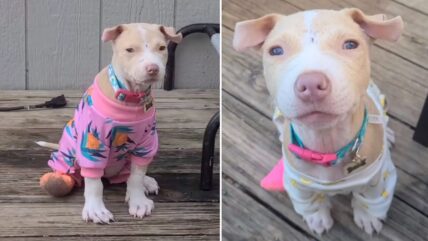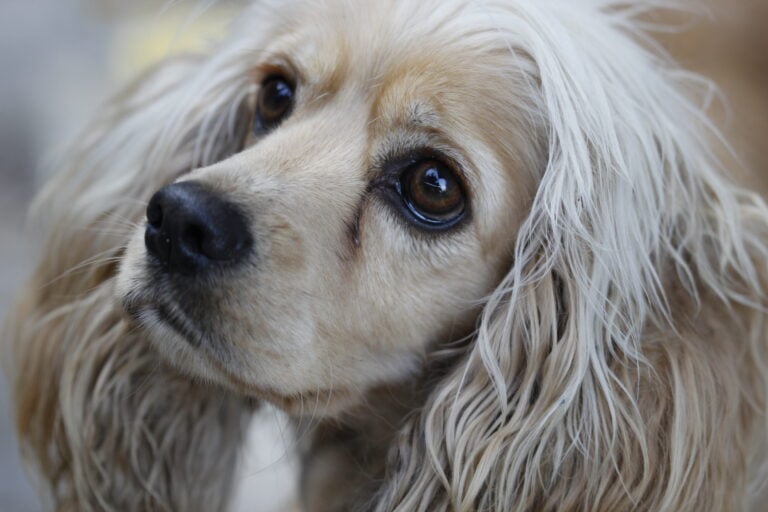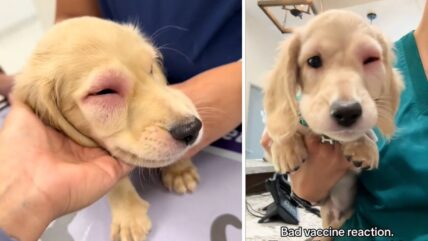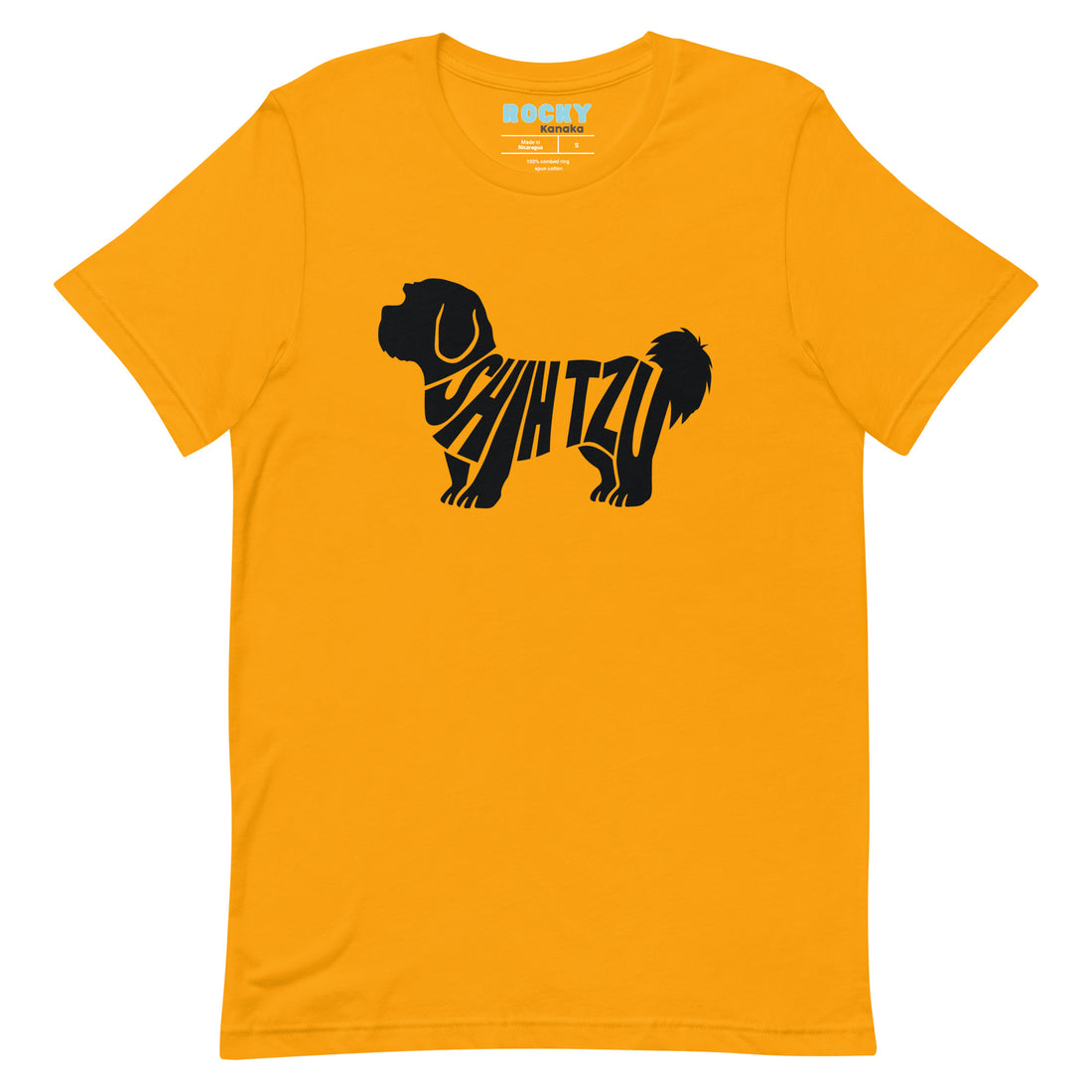Shih Tzu Owner Shares Little-Known Tip That Helped Clear Dog’s Tear Stains for Good
Does it always feel as though every time you lock eyes with your furry friend, they have these rusty, reddish-brown streaks flowing from the corner of their eyes? What the veterinary community call tear stains or epiphora? (Watch TikTok below)
It’s an issue that frustrates far too many dog owners, given how unattractive these stains look on our beautiful canine friends. If your dog has tear stains, it’s natural to wonder what may be causing the rusty marks and what you can do to get rid of them.

Well, one dog owner recently revealed what helped them clear the tear stains from her Shih Tzu named Junie for good: a change of diet. In a now-viral TikTok video posted on account @junietheshihtzu, the owner presents the before and after of their Junie’s struggle with tear stains, which had discolored almost her entire face.
According to the owner, Junie’s tear stains resulted from food allergies. Thankfully, after switching Junie to a hypoallergenic diet as per the veterinarian’s advice, these stains became a thing of the past.
“Junie is a unique case [because] the most common food allergy is chicken, but she was actually allergic to turkey. So now she has lean chicken, rice, veggies, probiotics, and supplements in her food,” replied Junie’s owner in the comment section.
Watch the video below:
@junietheshihtzu she acts like a puppy again too #beforeandafter #transformation #viraltiktok #crustywhitedog #shihtzu ♬ original sound – ❦
Tear Stains 101: What Causes Tear Stains in Dogs?
We can all agree that tear stains make our furry friends — especially light-colored dogs, whose stains are more noticeable — look somewhat sad and sorry.
The truth, though, is that these stains have nothing to do with your dog’s emotional state. Instead, they’re caused by a variety of factors. But before we dive right into these factors, let’s explore why tear stains in dogs have that hard-to-ignore rusty coloration.
You see, just like in humans, the red blood cells in your dog’s body break down naturally after a certain period to make way for new ones. The breakdown of these old red blood cells leads to the release of different waste products. Among these by-products are porphyrins.
Porphyrins are naturally occurring compounds loaded with iron. In dogs, these iron-carrying waste compounds are expelled through the tears, saliva, urine, and bile.
Now, the most common reason behind tear stains in dogs is excessive tear production (scientifically referred to as epiphora). Like us, our canine friends have tear ducts — also called nasolacrimal ducts — that empty the teary fluids from the eyes to the nasal cavity.
In other words, every time your dog’s eyes get watery, the tear ducts transport these tears, including the porphyrin-loaded tears, away from the eyes, draining them into the nose.
So, if your dog experiences increased tear production, some of the porphyrin-pigmented tears will overflow from the tear duct and down to the corners of their eyes. This rusty discoloration is often a result of the iron content in the porphyrin.
“When you look in the corner of a dog’s eyes, you may notice a red/brown discoloration in their tears. This comes from porphyrin, iron-containing molecules produced by the body when it breaks down iron. Porphyrins are excreted through the gastrointestinal tract, urine, saliva, and tears, explained expert dog groomer Gabriel Feitosa in an Instagram post.
The longer these porphyrin-loaded tear stains sit on your dog’s fur, the more discoloration they’ll cause.
5 Common Factors that Trigger Epiphora in Dogs
If you notice your dog gets tear stains too often, this could mean they’re experiencing excessive tear production (epiphora). This may be due to a number of factors, including:
1. Tear Duct Blockage
If your dog’s tear ducts get blocked, their eyes will often become watery due to the build-up of tears in the ducts. And as this happens, the porphyrin-pigmented tears will drain out of their eyes more than usual, causing persistent tear stains.
According to Veterinary Formula, flat-faced dog breeds — better known as brachycephalic breeds — are prone to blocked tear ducts and other related abnormalities. Due to their pushed-in faces, these breeds are likely to have narrower-than-average tear ducts and, ultimately, frequent tear stains. Breeds susceptible to tear staining include the Shih Tzu, Lhasa Apso, Pekingese, Boxer, Maltese, Boston Terrier, and Bulldog.
“I have two Malteses, 4 and 3 y/o. Their eyes produce a lot of tears, it’s more so with the younger one. And that creates dark tear marks around the eyes,” shared user @kakamba in a Reddit discussion on tear stains in Maltese dogs.
In most cases, dogs with blocked tear ducts will need to have their ducts unblocked by a veterinarian. Below is a video of vets flushing out the excess tear fluid trapped in a dog’s tear duct:
Source: @thevetyard
2. Food or Environmental Allergies
Dogs with food intolerances are at a higher risk of excessive tear production as their immune systems respond to the food allergen. This will, in turn, lead to constant tear stains.
“The only time my Shih Tzu ever had ear stains was when eating Merrick Kibble. I don’t know what it was about that brand, but after switching, his eyes barely water and the tear stains went away almost immediately,” commented user @sparklegirl407 in a Reddit discussion on tear stain issues in dogs.
Among the common food allergens in dogs’ diet include:
- Chicken
- Turkey
- Beef
- Pork
- Lamb
- Grains
- Dairy products
- Wheat
- Soy
In addition, dogs constantly exposed to environmental irritants such as pollen and dust are more likely to have teary eyes and, consequently, persistent tear stains.
3. Eye Issues (or Eye Infections)
In other cases, epiphora in dogs may be due to an underlying eye issue. According to pet health experts at VCA Hospitals, eye conditions such as corneal ulcers, glaucoma, conjunctivitis, and ectopic cilia can make your furry friend experience excessive tear production and staining.
Frequent eye infections may also make your dog’s eyes more irritated, leading to excessive tearing and staining.
4. Long Hair Around the Eyes
If your dog’s eyes are surrounded by so much hair, it means they’re exposed to a constant source of irritation. The excess hair will prick their eyes most of the time, making your dog tear up (and stain) more than usual.
5. Tap Water Impurities
Ever wondered, “Does tap water cause tear stains in dogs?” The short answer is yes. Tap water is high in minerals and, therefore, can contribute to tear stains in dogs. Some dogs may be extra sensitive to these minerals present, making them experience excessive tearing and staining.
“I’m a professional dog groomer, and a vet I work with says that the impurities in the tap water can actually come out through the eyes,” commented user @Foxynbynature in a Reddit discussion on dog tear stains.
How to Clear Tear Stains in Dogs
When it comes to removing tear stains in dogs, getting to the root cause of the staining can go a long way in resolving the issue for good. Since every dog is different, it’s not advisable to hop onto every “home remedy for tear stains in dogs” that you come across online.
What we’re trying to say is, before using any over-the-counter or homemade solution to remove your dog’s tear stains, speak to your first. They will be able to rule out any underlying issue that may be causing the tear staining and recommend an appropriate solution.
That said, here are some of the common ways to get rid of tear stains and keep your dog looking their best:
- Trim Hair Around the Eyes
Regularly trimming the overgrown hair around your dog’s eyes will protect them from constant irritation. If you’re uncomfortable doing the trimming by yourself, consider the services of a professional dog groomer.
- Review their Diet
If you suspect your dog’s tear stains may be due to food allergies, consult your vet before making any drastic dietary changes.
- Wipe their Eye Area Regularly
Create time each day to wipe off your dog’s face, especially the stained areas. Doing this often can help remove any trapped environmental allergens and prevent the build-up of tear stains (which can cause secondary infections).
You can clean their eyes using a clean cloth dampened with distilled water or doggy eye-cleaning wipes recommended by your vet. You can also consider adding a vet-approved tear stain removal solution to this cleaning routine.
- Consider Filtered Water
Switching from tap water to filtered or distilled water may help reduce your dog’s recurring tear stains.
“Filtered, distilled, bottled water worked for my little guy. Might take a month for the tear-stained hair to grow out,” commented user @Lb147 in a Reddit discussion on clearing tear stains in dogs.
Tear Stains in Dogs FAQs
What foods cause tear stains in dogs?
There are no specific foods that cause tear stains in dogs; it all depends on your dog’s food allergies. If your dog is allergic to a particular food ingredient in their diet, they may develop stubborn tear stains.
How to get rid of tear stains in dogs?
As explained earlier, there are different root causes for tear stains in dogs. So, it’s best to see the vet before trying out any home remedy or over-the-counter product to address the issue.
Best dog food to prevent tear staining in Maltese
It’s advisable to speak with your vet about which food to switch to if your Maltese constantly has tear stains.
What ingredient in dog food causes tear stains?
Any ingredient in dog food, from chicken to beef, turkey, grain, and lamb, can cause tear stains if your dog is allergic to it.
Does chicken cause tear stains in dogs?
As noted earlier, your dog may develop tear stains if they are allergic to chicken.
Does turkey cause tear stains in dogs?
Not all dogs that consume turkey get tear stains. Instead, those allergic to turkey are more prone to tear stains.
Does filtered water prevent tear stains in dogs?
Switching your dog from tap water to filtered water can help reduce repeated tear staining.
Best product to prevent tear stains in dogs?
It’s best to consult your vet about what product to use to clear your dog’s tear stains.
Does beef cause tear stains in dogs?
Yes, beef can cause tear stains if your dog is allergic to it.
Does distilled water prevent tear stains in dogs?
Distilled or filtered water can help tackle your dog’s tear-staining problem.
How do probiotics help with tear staining in dogs?
Probiotics can help with tear staining in dogs by promoting a healthier gut microbiome, which can reduce the chance of tear stains caused by imbalances in the digestive system. Tear staining, often linked to a buildup of the dye molecule called porphyrin, can sometimes be exacerbated by poor digestion or diet. Adding probiotics to your dog’s regimen may help reduce the appearance of stains by improving their overall health from the inside out.
What’s the best way to get rid of tear stains in white dogs?
Probiotics can help with tear staining in dogs by promoting a healthier gut microbiome, which can reduce the chance of tear stains caused by imbalances in the digestive system. Tear staining, often linked to a buildup of the dye molecule called porphyrin, can sometimes be exacerbated by poor digestion or diet. Adding probiotics to your dog’s regimen may help reduce the appearance of stains by improving their overall health from the inside out.
How does baking soda help with tear stains in dogs?
Baking soda can help clean and lighten tear stains in dogs due to its mild abrasive and bleaching properties. To use it, mix a small amount of baking soda with water to form a paste, apply it gently to the stained area, and rinse thoroughly after a few minutes. Be careful not to get any into the dog’s eyes. Additionally, addressing underlying health conditions that contribute to tear staining, such as excessive tear production or skin irritation, is important.
Can apple cider vinegar reduce tear stains in dogs?
Yes, apple cider vinegar may help reduce tear stains in dogs by balancing the pH levels in their body. You can add a small amount (usually a teaspoon) of apple cider vinegar to your dog’s water to help reduce the appearance of tear stains. However, it’s essential to ensure that any underlying health condition causing the excessive tearing, such as infections or allergies, is addressed as well.
Is Desitin safe for treating tear stains in dogs?
Desitin, a zinc oxide-based diaper rash cream, has been suggested by some pet owners for treating tear stains in dogs. However, it’s essential to use it cautiously and ensure that it doesn’t come into contact with the dog’s eyes, as it can cause irritation. Applying a thin layer around the stained area may help protect the skin, but always consult with a vet before using products not specifically designed for dogs.
Can colloidal silver help with tear stains in dogs?
Colloidal silver may help reduce tear stains in dogs due to its antimicrobial properties, which can help prevent infections that may lead to excessive tearing. Some owners use colloidal silver as a topical solution to clean the stained area gently. However, it’s crucial to address the root cause of tear stains, whether it’s due to a health condition, diet, or environmental factors.
Can apple cider vinegar cause tear stains in dogs?
While apple cider vinegar is often used to help reduce tear stains by balancing the dog’s pH levels, excessive or improper use of it might lead to tear stains in some cases. For example, if the vinegar irritates the dog’s digestive or urinary systems, it could result in excessive tearing. Always introduce apple cider vinegar to your dog’s diet in small amounts and monitor for any adverse effects.
What health conditions can cause dogs to get tear stains?
Tear staining, also known as epiphora, can be caused by several health conditions in dogs, including eye infections, allergies, clogged tear ducts, or even dental problems. In some cases, tear staining may result from a buildup of porphyrin, a dye molecule in tears. If your dog suddenly develops tear stains, it’s important to have them checked by a vet to rule out any underlying health conditions.









